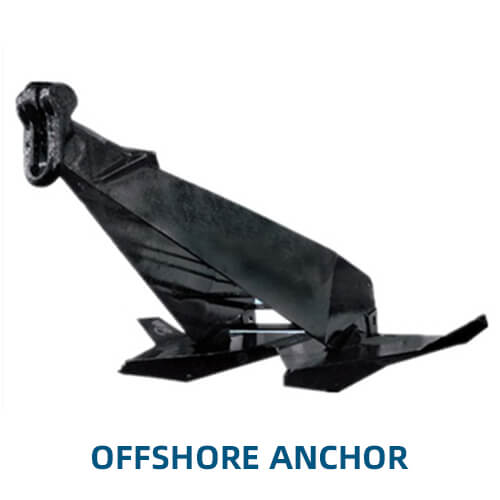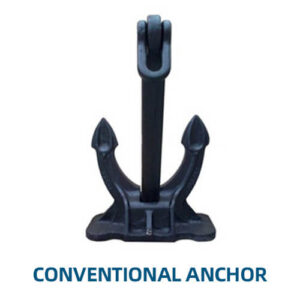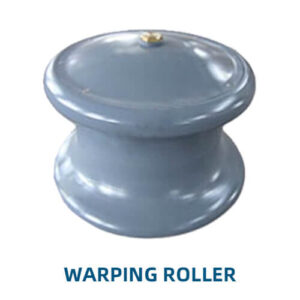An Offshore anchor have the strength and reliability needed to secure large structures and vessels. Therefore, they are a crucial component in the stability and safety of offshore operations since they
Key Features of Offshore Anchor:
-
High Holding Power:
- Offshore anchors provide exceptional holding power, ensuring that the vessel or structure remains securely anchored even in extreme conditions. They are often classified as High Holding Power (HHP) or even Super High Holding Power (SHHP) anchors, depending on their design and performance characteristics.
-
Heavy-Duty Construction:
- Material: Manufactured using high-strength steel, offshore anchors can withstand the harsh marine environment.
- Size and Weight: Offshore anchors are significantly larger and heavier than those used for smaller vessels or nearshore applications. The increased weight contributes to their holding power and stability.
-
Design:
- Flukes: Offshore anchors generally have large, well-designed flukes. Therefore, it can penetrate deeply into the seabed, providing strong resistance to horizontal forces.
- Shank: The shank positions the flukes optimally for digging into the seabed and maintaining a secure hold. Some offshore anchors feature a hinged shank to allow for better alignment with the seabed during setting.
- Anchor Types: Common types of offshore anchors include drag embedment anchors (like the Bruce or Delta), suction anchors, and pile anchors, each suited to different seabed conditions and anchoring needs.
-
Seabed Compatibility:
- Offshore anchors perform effectively across various seabed types, including mud, sand, clay, gravel, as well as rock. Choose the anchor based on the specific seabed conditions at the deployment site.
-
Deployment and Recovery:
- Anchor Handling Equipment: Deploying and retrieving offshore anchors requires specialized equipment, such as anchor handling vessels (AHVs) equipped with powerful winches, cranes, and dynamic positioning systems.
- Mooring Systems: Offshore anchors are often part of complex mooring systems, including chains, wire ropes, and synthetic lines, which connect the anchor to the floating structure or vessel.
Types of Offshore Anchor:
-
Drag Embedment Anchors:
- Bruce (Claw) Anchor: They can set quickly and hold in a variety of seabeds. As a result, they can secure offshore vessels and floating structures. It is particularly effective in sandy or muddy conditions.
- Delta (Plow) Anchor: The Delta anchor features a sharp, plow-like design that allows it to dig deeply into the seabed. As a result, it is effective in various seabed conditions.
-
Suction Anchors:
- Design: Suction anchors are large, cylindrical structures. Once in place, they provide extremely high holding power, making them suitable for securing large offshore structures such as oil rigs and floating platforms.
- Use: Suction anchors are ideal for deepwater applications. We use them in mooring systems for floating production storage and offloading (FPSO) units, as well as subsea installations.
-
Pile Anchors:
- Design: Pile anchors are driven deep into the seabed, usually by piling hammers or drilling. They rely on friction and the weight of the surrounding soil or rock to provide holding power.
- Use: Pile anchors are used in fixed offshore structures like oil platforms or wind turbines, where permanent and reliable anchoring is essential.
-
Plate Anchors:
- Design: Plate anchors are flat, steel plates that are installed into the seabed using a vertical or horizontal orientation. Commonly used in soft seabeds.
- Use: Plate anchors are used in mooring systems for semi-submersible platforms and other offshore applications.
Applications of Offshore Anchors:
- Oil and Gas Platforms: Offshore anchors are critical for securing drilling rigs, production platforms, and other infrastructure in the oil and gas industry.
- Floating Wind Turbines: The renewable energy sector is growing. As a result offshore anchors are installed to secure floating wind turbines in deep waters.
- Mooring of Vessels: Large vessels such as tankers, cargo ships, and floating production storage and offloading units (FPSOs) rely on offshore anchors as part of their mooring systems.
- Subsea Installations: Anchors can secure various subsea structures, including pipelines, manifolds, and communication cables.
Advantages of Offshore Anchor:
- Reliability: Offshore anchors provide a secure and stable mooring solution, even in extreme offshore conditions.
- Versatility: They can adapt to various seabed types and are compatible with a wide range of offshore structures and vessels.
- High Holding Capacity: Offshore anchors are capable of withstanding significant forces, ensuring the safety and stability of the anchored structure.
Considerations for Using Offshore Anchors:
- Seabed Survey: A detailed seabed survey is essential to determine the best type of anchor for a specific offshore site.
- Environmental Conditions: We need to choose the anchor based on the expected environmental conditions, including wind, waves, and currents.
- Installation Expertise: Deploying and securing offshore anchors requires specialized knowledge and equipment, often involving complex mooring systems.






